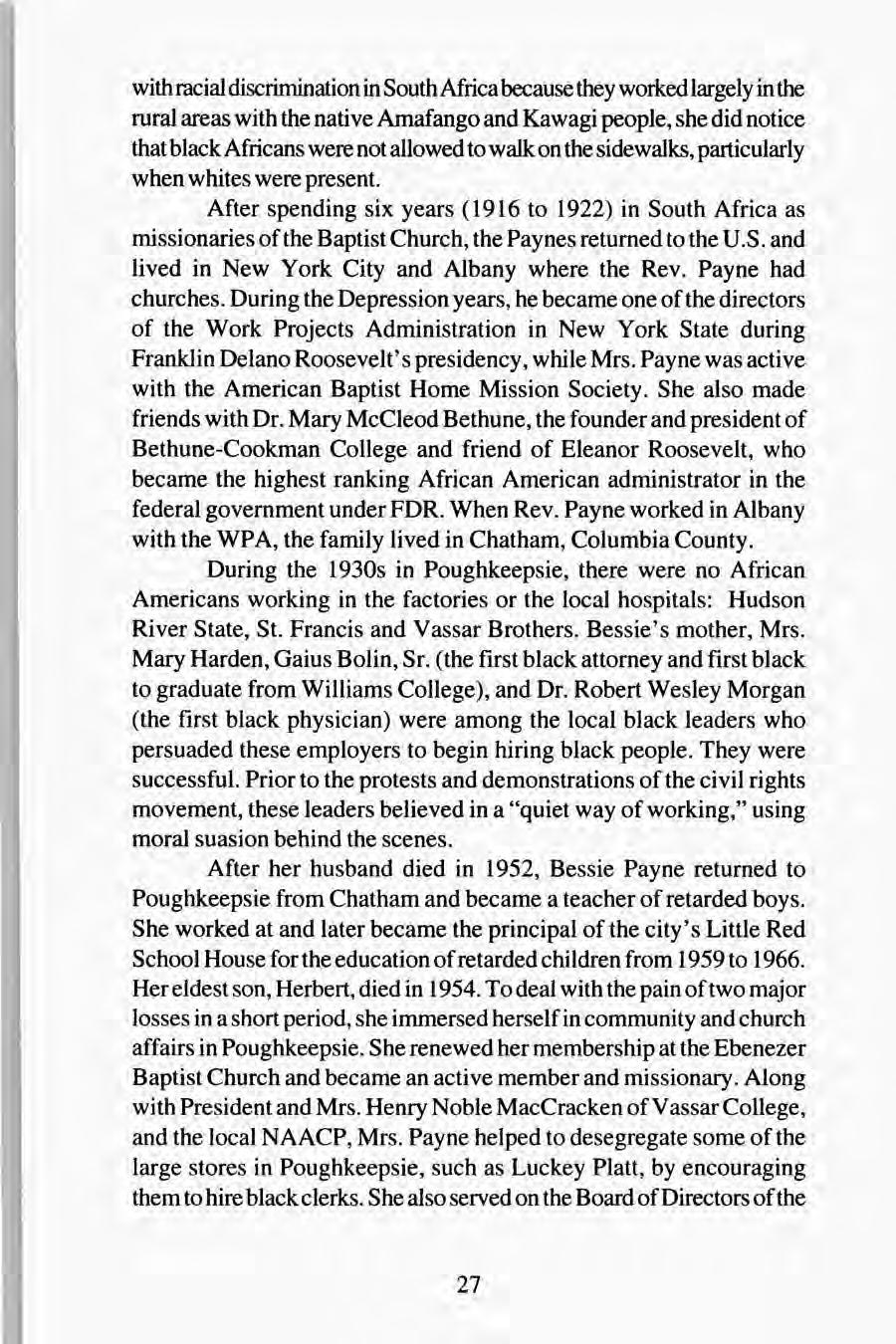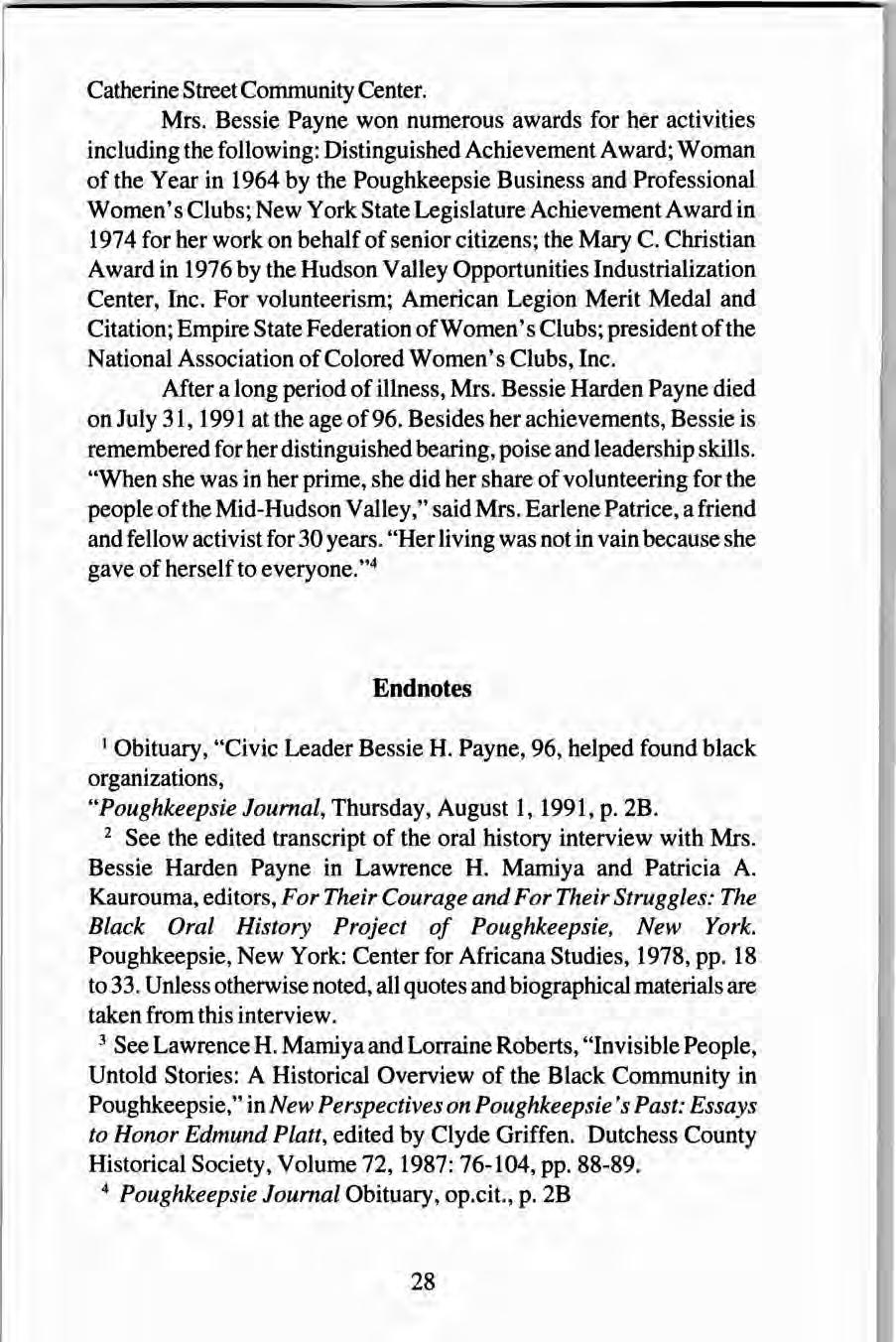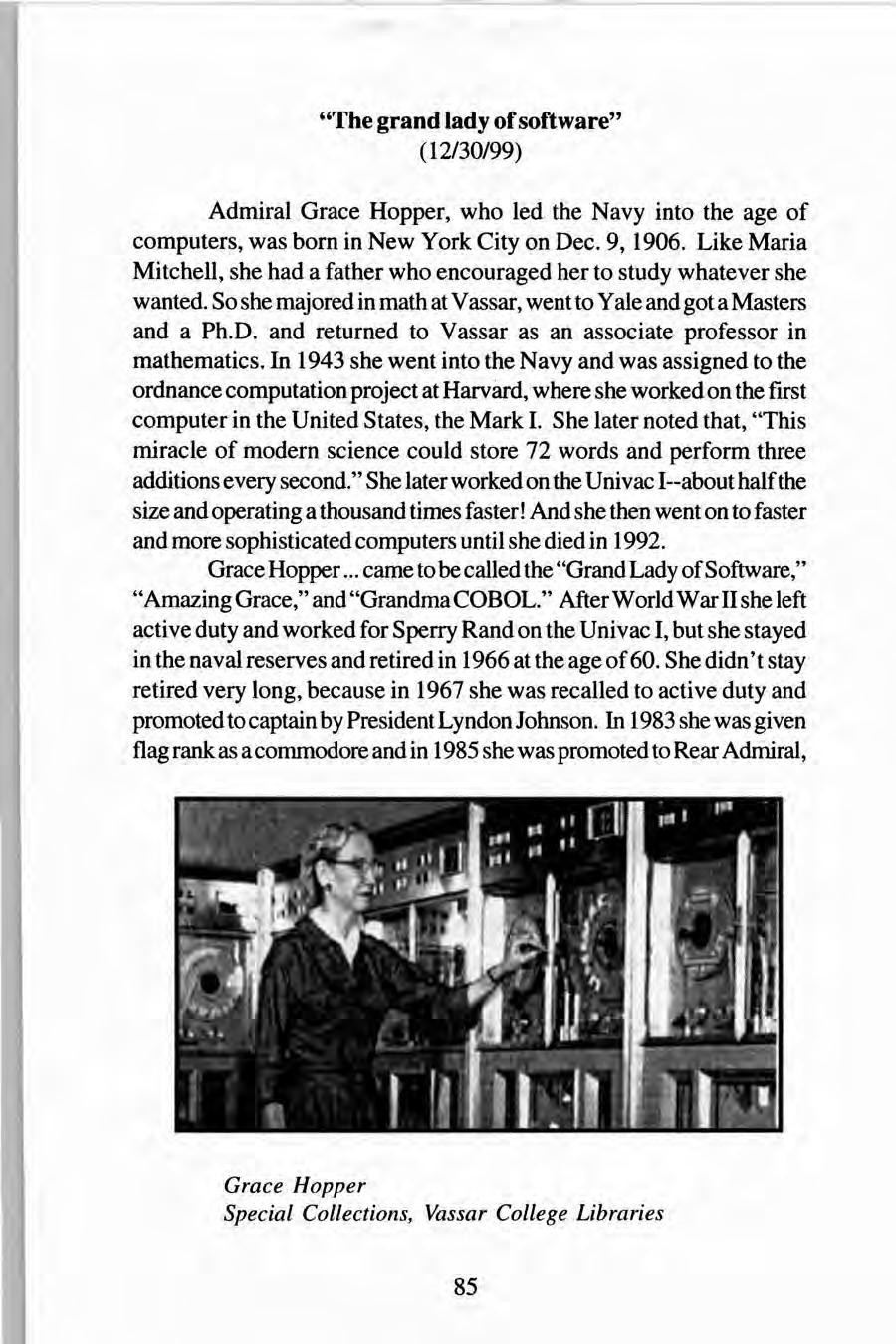
9 minute read
Mrs. Bessie Harden Payne
BESSIE HARDEN PAYNE (1895 -1991)
By Lawrence H. Mamiya
Lawrence Mamiya is the Paschall-Davis Professor of Africana Studies and Religion at Vassar College. He is the co-editor with Patricia A. Kaurouma of "For Their Courage and For Their Struggles: The Black Oral History Project of Poughkeepsie, NY," and co-author with Lorraine Roberts of "Invisible People, Untold Stories: A Historical Overview of the Black Community in Poughkeepsie. "
Bessie Harden Payne and Rev. Herbert A. Payne
Mrs. Bessie Harden Payne, a native Poughkeepsian, was a prominent, distinguished and articulate leader in the African American community in the city of Poughkeepsie. She was a "driving force behind many of the city's black civic organizations." 1 Born in Poughkeepsie on January 16, 1895, she was the daughter of John and Mary M. Woods Harden. Her paternal grandfather, Mr. James Harden, came from Highland, New York and worked as a waiter on the Hudson River boats in the late nineteenth century. Mr. Harden had also fought in the Civil War. Bessie's mother, Mrs. Mary M. Woods Harden, came to Poughkeepsie in 1892 from Stonington, Connecticut, where her maternal grandfather was a freedman in the early nineteenth century and her father, Henry Woods, worked as a constable in Stonington. Educated in Poughkeepsie schools, Bessie Harden became one of the first black graduates of Poughkeepsie High School, matriculating in the
class of 1913. Recalling her education, Mrs. Payne said, "I was the first colored to graduate in a number of years. I don't think there were but about 500 Negroes all together in Poughkeepsie at that time. And of course, there weren't that many young people to go to school." 2 As one of the few African-American students in Poughkeepsie's public schools, she did encounter a few incidents of racial discrimination. In the sixth grade, a Miss Tuttle invited her class to her home for a social gathering and Bessie informed her mother that she was going to be late that day. When the group reached the comer of the street where the Hardens lived, Miss Tuttle said, "Bessie, you can go home, you don't have to go with us." After arriving home early, she told her mother what had happened. The next day Mrs. Harden accompanied her daughter to school and spoke with Miss Tuttle. "I don't know what she said to Miss Tuttle but she was always very kind to me after that." During her childhood years, Bessie Harden pointed out that there was a level of"de facto" racial discrimination in some of the local hotels and restaurants. The Nelson House, for example, did not hire Negroes to work there for a long period of time. After some pressure by local leaders in the late twenties, Negroes worked there as porters and waiters, but they could not stay overnight in the Nelson House. Bessie's father John Harden worked at the Nelson House as a waiter for thirty years. She recalled that when the famous singer Marian Anderson performed at the Bardavon Opera House, the audience was still applauding while Ms. Anderson was being driven back to the train station by Rev. Payne because she could not stay overnight in a hotel in the Queen City of the Mid-Hudson. Other famous black performers like Roland Hayes and Langston Hughes encountered similar kinds of discrimination, returning to New York City after their performances in Poughkeepsie. The Smith Brothers Cough Drop Company also had a restaurant that did not hire black people or let them eat there. The Ebenezer Baptist Church, which laid the cornerstone of its building in 1905 and was led by the Rev. Charles Ferris, was very important in the formation of Bessie's life. Her mother, Mrs. Mary Harden, was the superintendent of the Sunday School and also played the piano for worship services. Ebenezer became the center of Bessie's social life and activities. Most of her close friends were members of the Baptist Young People's Union which met every Wednesday night. The family also spent all day Sunday at the church with worship service at 11 a.m., dinner at the church, Sunday School at 3 p.m., followed by an

evening service. In 1913, Mrs. Mary Harden and her daughter Bessie gathered a group of 10 women to start the Poughkeepsie Neighborhood Club. Mrs. Harden also served as the president of the club until her death in 1948. The purpose of the club was to help women do civic work and to help uplift womanhood in general. It brought outstanding Negro speakers to Poughkeepsie for lectures. It also encouraged churches and community groups to observe Emancipation Day and Negro History Sunday. In 1917 the club sponsored its first Lincoln-Douglass dinner. During the first week of every April, the club supported Negro Health Week. The Poughkeepsie Neighborhood Club became a member of the United Federation of Negro Women, which was organized by the famous educator and college president, Dr. Mary McCleod Bethune. The club also played an informal role in social change by encouraging black professionals like Dr. Garrett Price to relocate to Poughkeepsie. The Catherine Street Community Center, which was established in 1922, was an outgrowth of the Poughkeepsie Neighborhood Club. The club experience became significant for Bessie Harden when in later life she was elected as the president of the National Association of Colored Women's Clubs, Inc. 3 These women's clubs were the forerunner of the women's movement in black communities. After graduating from Poughkeepsie High School, Bessie attended Virginia Seminary College in Lynchburg, Virginia where she married her husband, the Rev. Herbert A. Payne, who was then training for the ministry. Married on November13, 1915, they had two sons: Herbert Harden who was born in South Africa and John who was born in Poughkeepsie. Two daughters, Rosemary and Nada, died as infants. Although she desired to do missionary work in India after hearing a speaker in high school, Bessie agreed to follow her husband to do mission work for the Baptists in South Africa in 1916 during World War I. Their boat took a longer route along the South American coast to South Africa due to the fear of German submarines. While her husband was busy with missionary work, she taught the sixth grade in a Baptist-run school. Mrs. Payne was also puzzled by the apartheid system in South Africa, especially in regard to the fine racial gradations found there. "Well, to see an advertisement in the paper for a nurse is really amusing. Some want a native, some want a three-fourth colored, some a four-fifth colored---! don't know how they figure it." While she claimed that neither she nor her husband had encountered problems

with racial discrimination in South Africa because they worked largely in the rural areas with the native Amafango and Kawagi people, she did notice that black Africans were not allowed to walk on the sidewalks, particularly when whites were present. After spending six years ( 1916 to 1922) in South Africa as missionaries of the Baptist Church, the Paynes returned to the U.S. and lived in New York City and Albany where the Rev. Payne had churches. During the Depression years, he became one of the directors of the Work Projects Administration in New York State during Franklin Delano Roosevelt's presidency, while Mrs. Payne was active with the American Baptist Home Mission Society. She also made friends with Dr. Mary McCleod Bethune, the founder and president of Bethune-Cookman College and friend of Eleanor Roosevelt, who became the highest ranking African American administrator in the federal government under FDR. When Rev. Payne worked in Albany with the WP A, the family lived in Chatham, Columbia County. During the 1930s in Poughkeepsie, there were no African Americans working in the factories or the local hospitals: Hudson River State, St. Francis and Vassar Brothers. Bessie's mother, Mrs. Mary Harden, Gaius Bolin, Sr. (the first black attorney and first black to graduate from Williams College), and Dr. Robert Wesley Morgan (the first black physician) were among the local black leaders who persuaded these employers to begin hiring black people. They were successful. Prior to the protests and demonstrations of the civil rights movement, these leaders believed in a "quiet way of working," using moral suasion behind the scenes. After her husband died in 1952, Bessie Payne returned to Poughkeepsie from Chatham and became a teacher of retarded boys. She worked at and later became the principal of the city's Little Red School House for the education of retarded children from 1959 to 1966. Her eldest son, Herbert, died in 1954. To deal with the pain of two major losses in a short period, she immersed herself in community and church affairs in Poughkeepsie. She renewed her membership at the Ebenezer Baptist Church and became an active member and missionary. Along with President and Mrs. Henry Noble MacCracken of Vassar College, and the local NAACP, Mrs. Payne helped to desegregate some of the large stores in Poughkeepsie, such as Luckey Platt, by encouraging them to hire black clerks. She also served on the Board of Directors of the

Catherine Street Community Center. Mrs. Bessie Payne won numerous awards for her activities including the following: Distinguished Achievement Award; Woman of the Year in 1964 by the Poughkeepsie Business and Professional Women's Clubs; New York State Legislature Achievement Award in 1974 for her work on behalf of senior citizens; the Mary C. Christian Award in 1976 by the Hudson Valley Opportunities Industrialization Center, Inc. For volunteerism; American Legion Merit Medal and Citation; Empire State Federation of Women's Clubs; president of the National Association of Colored Women's Clubs, Inc. After a long period of illness, Mrs. Bessie Harden Payne died on July 31, 1991 at the age of 96. Besides her achievements, Bessie is remembered for her distinguished bearing, poise and leadership skills. "When she was in her prime, she did her share of volunteering for the people of the Mid-Hudson Valley," said Mrs. Earlene Patrice, a friend and fellow activist for 30 years. "Her living was not in vain because she gave of herself to everyone. "4
Endnotes

1 Obituary, "Civic Leader Bessie H. Payne, 96, helped found black organizations, "Poughkeepsie Journal, Thursday, August 1, 1991, p. 2B. 2 See the edited transcript of the oral history interview with Mrs. Bessie Harden Payne in Lawrence H. Mamiya and Patricia A. Kaurouma, editors, For Their Courage and For Their Struggles: The Black Oral History Project of Poughkeepsie, New York. Poughkeepsie, New York: Center for Africana Studies, 1978, pp. 18 to 33. Unless otherwise noted, all quotes and biographical materials are taken from this interview. 3 See Lawrence H. Mamiya and Lorraine Roberts, "Invisible People, Untold Stories: A Historical Overview of the Black Community in Poughkeepsie," in New Perspectives on Poughkeepsie's Past: Essays to Honor Edmund Platt, edited by Clyde Griffen. Dutchess County Historical Society, Volume 72, 1987: 76-104, pp. 88-89. 4 Poughkeepsie Journal Obituary, op.cit., p. 2B










